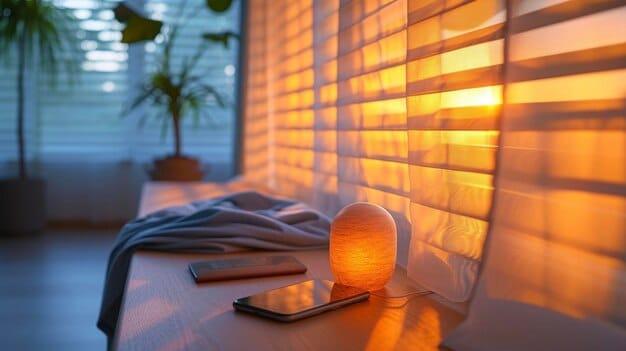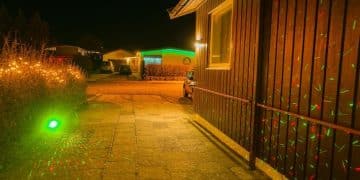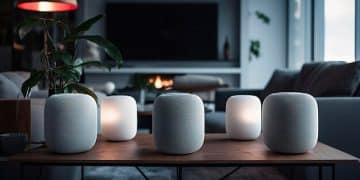Smart Lighting: Boost Sleep & Productivity by 20% with Circadian Lighting

Smart lighting trends, particularly circadian lighting, offer significant potential to improve sleep and productivity by mimicking natural light patterns, thereby regulating the body’s internal clock and enhancing overall well-being by up to 20%.
Are you looking to enhance your sleep quality and boost productivity? Discover how the latest smart lighting trends, especially the integration of circadian lighting, can make a significant difference in your daily life.
Understanding Circadian Lighting
Circadian lighting is designed to mimic the natural patterns of sunlight throughout the day. This approach helps regulate our internal biological clock, known as the circadian rhythm, which influences sleep, alertness, and overall health.
By adjusting the color temperature and intensity of light, circadian lighting can signal to our bodies when it’s time to be awake and when it’s time to rest. This synchronization is crucial for maintaining a healthy sleep-wake cycle and optimizing cognitive functions.
The Science Behind Circadian Rhythms
Our circadian rhythm is a roughly 24-hour cycle that governs various physiological processes. Light is the primary external cue that influences this rhythm, affecting the production of hormones like melatonin and cortisol.
How Light Affects Sleep and Productivity
Exposure to blue light in the evening can suppress melatonin production, making it harder to fall asleep. Conversely, exposure to blue-enriched light in the morning can increase alertness and productivity. Circadian lighting aims to leverage these effects to our benefit.
- Optimizing hormone production
- Enhancing alertness during the day
- Improving sleep quality at night
Ultimately, understanding the science behind circadian rhythms is essential for appreciating the potential of smart lighting to improve our daily lives.
Benefits of Smart Lighting for Sleep
One of the most significant advantages of smart lighting is its ability to enhance sleep quality. By creating a sleep-friendly environment, smart lights can help you fall asleep faster and enjoy more restful nights.
The ability to customize light settings according to your sleep schedule can lead to improved sleep habits and overall well-being. Let’s explore the specific ways smart lighting achieves this.

Reducing Blue Light Exposure Before Bed
Smart lights can be programmed to emit warmer, redder tones in the evening, minimizing blue light exposure. This shift helps your body produce melatonin, the hormone that promotes sleepiness, making it easier to fall asleep naturally.
Creating a Relaxing Bedtime Routine
With smart lighting, you can automate a gradual dimming of lights as bedtime approaches. This gentle transition signals to your body that it’s time to wind down, creating a relaxing and consistent bedtime routine.
- Automated dimming schedules
- Customizable light scenes for relaxation
- Integration with sleep tracking apps
By strategically using smart lighting, you can create an environment that naturally encourages better sleep.
Boosting Productivity with Smart Lighting
In addition to improving sleep, smart lighting can significantly boost productivity during the day. By mimicking natural daylight, smart lights can enhance alertness, focus, and overall cognitive performance.
The right light can stimulate wakefulness and improve mood, leading to increased efficiency and creativity. Understanding how to optimize your lighting for productivity is key.
Simulating Natural Daylight
Smart lights can be programmed to emit brighter, bluer tones in the morning, simulating natural daylight. This exposure to blue-enriched light helps suppress melatonin and increase cortisol, making you feel more awake and alert.
Personalizing Lighting for Different Tasks
Different tasks require different lighting conditions. Smart lighting allows you to customize light settings based on the task at hand, whether it’s reading, working on a computer, or engaging in creative activities.

- Adjustable brightness and color temperature
- Preset lighting modes for different tasks
- App integration for easy control
By tailoring your lighting to match your activities, you can optimize your work environment for maximum productivity.
Choosing the Right Smart Lighting System
Selecting the right smart lighting system is essential for reaping its benefits. Consider factors such as compatibility with your existing smart home devices, ease of use, and the range of features offered.
Different systems offer varying levels of customization and control. Evaluating your needs will help you make an informed decision.
Compatibility and Integration
Ensure that the smart lighting system you choose is compatible with your existing smart home ecosystem. Look for systems that integrate seamlessly with popular platforms like Amazon Alexa, Google Assistant, and Apple HomeKit.
Features and Customization Options
Consider the range of features offered by different smart lighting systems. Look for systems that allow you to adjust brightness, color temperature, and create custom lighting scenes.
Ease of Use and Installation
Choose a smart lighting system that is easy to install and use. Look for systems with intuitive apps and straightforward setup processes. User-friendly systems will encourage you to leverage the full range of features.
By considering these factors, you can select a smart lighting system that meets your needs and enhances your living space.
Implementing Circadian Lighting at Home
Implementing circadian lighting at home involves strategic placement of smart lights and careful programming of lighting schedules. The goal is to create an environment that supports your natural circadian rhythm.
Consider the specific needs of different rooms and adjust lighting accordingly. A personalized approach is key to maximizing the benefits.
Bedroom Lighting Strategies
In the bedroom, focus on creating a calming and sleep-inducing environment. Use smart lights that can emit warm, red tones in the evening and gradually dim as bedtime approaches.
Home Office Lighting Strategies
In the home office, prioritize lighting that promotes alertness and focus. Use smart lights that can emit brighter, bluer tones in the morning and allow you to adjust the lighting based on the task at hand.
- Strategic placement of smart lights
- Customized lighting schedules
- Regular adjustments based on personal preferences
By implementing these strategies, you can create a home environment that supports your circadian rhythm and enhances your well-being.
The Future of Smart Lighting
The future of smart lighting is promising, with ongoing advancements in technology and increasing integration with other smart home devices. Expect to see more sophisticated systems that offer personalized lighting recommendations and even adapt to your daily activities automatically.
Innovation will continue to drive new possibilities for enhancing health, productivity, and overall quality of life.
Advancements in LED Technology
Ongoing advancements in LED technology are leading to more energy-efficient and customizable smart lights. Expect to see LEDs with wider color ranges, higher brightness levels, and longer lifespans.
Integration with AI and Machine Learning
The integration of AI and machine learning will enable smart lighting systems to learn your preferences and automatically adjust lighting settings based on your daily activities and sleep patterns.
Sustainability and Energy Efficiency
Future smart lighting systems will prioritize sustainability and energy efficiency. Expect to see more eco-friendly materials and technologies that reduce energy consumption and minimize environmental impact.
The ongoing evolution of smart lighting technology promises to transform the way we illuminate our homes and improve our lives.
| Key Point | Brief Description |
|---|---|
| 💡 Circadian Rhythm | Regulates sleep and alertness through natural light patterns. |
| 🌙 Sleep Improvement | Reduces blue light exposure for better sleep quality. |
| ☀️ Productivity Boost | Simulates daylight to enhance focus and energy. |
| 🏡 Smart Home Integration | Seamlessly works with Alexa, Google Assistant, and more. |
▼
Circadian lighting is a type of smart lighting that mimics natural sunlight patterns. It adjusts color temperature and intensity to regulate our internal biological clock for better sleep and alertness.
▼
Smart lighting reduces blue light exposure before bed by emitting warmer tones. This promotes melatonin production, making it easier to fall asleep naturally and improve overall sleep quality.
▼
Yes, smart lighting can boost productivity by simulating natural daylight. Brighter, bluer tones in the morning increase alertness and focus, leading to improved cognitive performance throughout the day.
▼
Consider compatibility with your existing devices, available features, and ease of use. Look for systems that integrate with platforms like Alexa, Google Assistant, and offer customizable options.
▼
Future trends include advancements in LED technology, integration with AI for personalized lighting, and a focus on sustainability. These innovations promise more efficient and adaptable lighting solutions.
Conclusion
Embracing smart lighting trends, especially circadian lighting, presents a significant opportunity to enhance your sleep and productivity. By mimicking natural light patterns, these systems can regulate your circadian rhythm, leading to improved well-being and a more balanced lifestyle. Consider exploring the possibilities of smart lighting to transform your home and daily routines.





